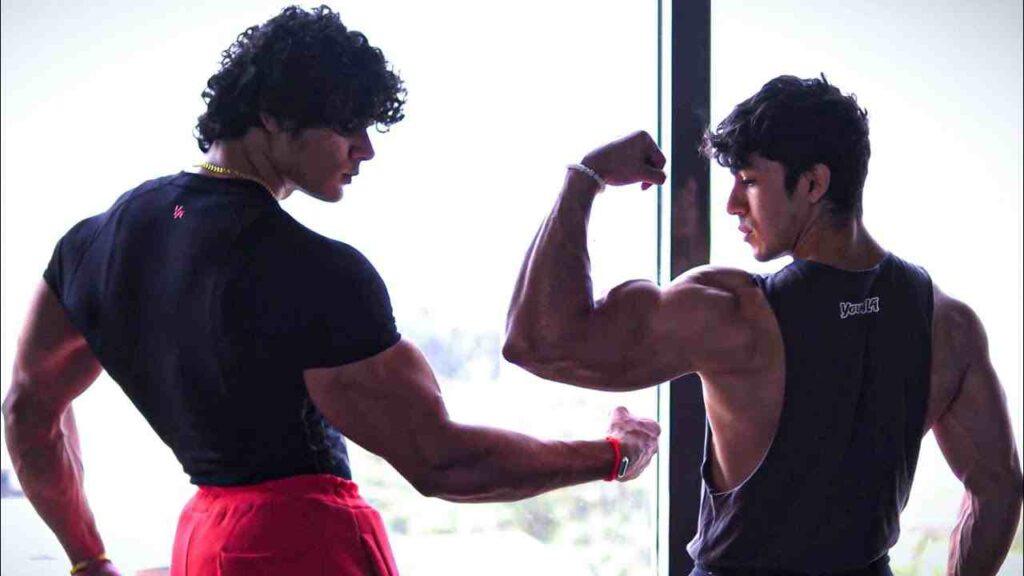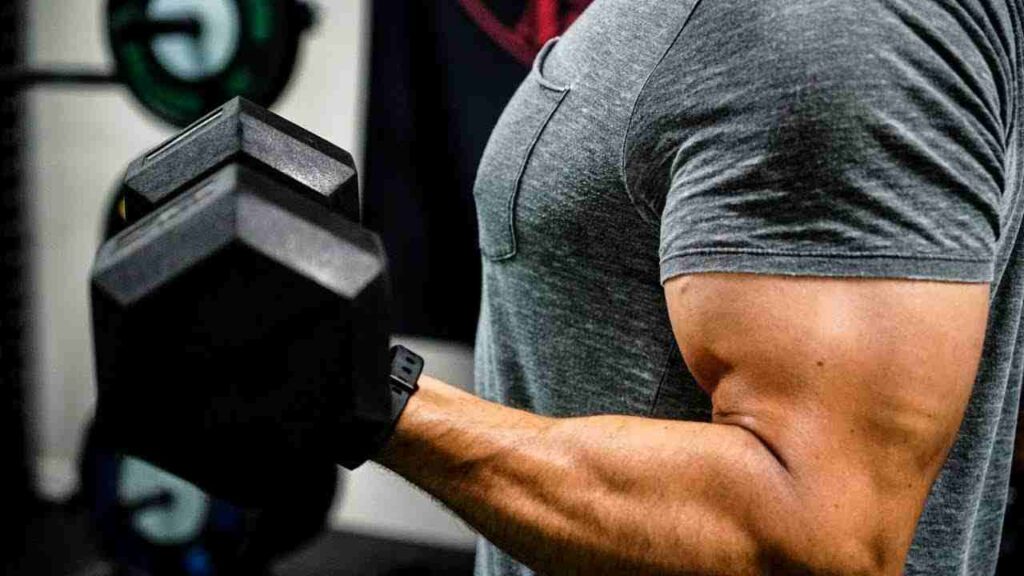Introduction
Welcome to the world of fitness, where a strong upper body isn’t just about aesthetics – it’s about functionality and overall health. If you’re looking for a workout routine that targets your back and biceps, using nothing more than a pair of dumbbells, you’re in the right place. This article is your guide to unlocking the power of a well-rounded back and bicep workout with dumbbells.
Whether you’re a fitness novice or a seasoned gym-goer, this routine is designed to enhance your strength, posture, and muscle symmetry. Join us as we explore the benefits, techniques, exercises, and strategies that will propel you towards mastering the art of the back and bicep workout with dumbbells.
Benefits of Back and Bicep Workouts with Dumbbells
Engaging in back and bicep workouts with dumbbells offers a range of benefits. By focusing on these muscle groups, you promote a well-rounded upper body strength and appearance. Strengthening the back muscles helps improve posture, reducing the risk of discomfort and injuries. Additionally, bicep exercises enhance arm aesthetics and functional strength for everyday tasks.
Dumbbells provide versatility, allowing you to target specific areas and work on muscle imbalances effectively. This workout combination also stimulates muscle growth and metabolism, aiding in fat loss. Overall, incorporating back and bicep exercises with dumbbells into your routine contributes to a balanced, resilient, and aesthetically pleasing upper body.
Essential Dumbbell Techniques
Absolutely, mastering the essential dumbbell techniques is crucial for an effective back and bicep workout. Here are the key steps to ensure you’re using the proper form:
- Grip: Hold the dumbbells firmly with an overhand grip. Your palms should be facing your body. Maintain a neutral wrist position to avoid strain.
- Stance: Stand with your feet shoulder-width apart for stability. Keep a slight bend in your knees and engage your core for proper posture.
- Lift: Initiate the movement from your muscles, not by using momentum. Lift the dumbbells using controlled motion, exhaling as you exert force.
- Range of Motion: Perform the exercises through a full range of motion. This ensures optimal muscle activation and development.
- Controlled Repetitions: Lower the dumbbells slowly and under control, emphasizing the eccentric (negative) phase of the movement. Aim for a smooth, steady rhythm.
- Breathing: Breathe naturally throughout the exercise. Inhale during the eccentric phase and exhale during the concentric phase (when lifting the weight).
- Proper Posture: Maintain a neutral spine and avoid excessive arching or rounding of the back. This minimizes the risk of injury.
- Start with Light Weights: If you’re new to these exercises, begin with light weights to master the form before progressing to heavier loads.
SHOP FOR THE BEST FITNESS GUIDE E-BOOK
Remember, using the proper technique is vital to prevent injuries and ensure you’re effectively targeting the intended muscles.
Different Types of Dumbbells and Their Suitability
Dumbbells are versatile fitness equipment that comes in various types, each offering unique advantages based on your fitness goals, preferences, and workout space. Choosing the right type of dumbbells can significantly impact the effectiveness and comfort of your back and bicep workout. Here, we’ll explore different types of dumbbells and their suitability for different situations:
- These are the classic dumbbells you often see in gyms, where the weight is fixed and cannot be adjusted.
- Ideal for beginners and those who prefer a straightforward workout without the need for weight adjustments.
- Suited for exercises where you’ll be using the same weight throughout the routine.
- These dumbbells allow you to change the weight plates according to your desired intensity level.
- Perfect for those who want to progress in their workouts or have limited space for multiple dumbbell sets.
- Suitable for versatile workouts, as you can adjust the weight for different exercises within the same routine.
3. Selectorized Dumbbells:
- These advanced dumbbells enable you to change the weight with the turn of a dial or the pull of a pin.
- Great for people who want a seamless transition between different exercises without interrupting their flow.
- Best suited for circuit training or fast-paced workouts.
4. Neoprene Dumbbells:
- Neoprene-coated dumbbells have a soft, comfortable grip and come in various colors and sizes.
- Ideal for home workouts or those who prioritize comfort and aesthetics.
- Suited for lighter exercises or beginners.
- These dumbbells have a hexagonal shape and rubber coating, which prevents damage to floors and reduces noise.
- Suitable for home gyms and commercial gyms where protecting the floor is essential.
- Great for heavy lifting exercises and compound movements.
6. Adjustable Dumbbell Sets:
- These sets often come with a range of weight plates and a bar, allowing you to customize the weight for each dumbbell.
- Perfect for those who want a variety of weight options without the clutter of multiple dumbbells.
- Suited for comprehensive workout routines targeting various muscle groups.
7. PowerBlock Dumbbells:
- PowerBlock dumbbells are compact, stackable, and adjustable, with a pin or lever mechanism to change weights.
- Ideal for individuals with limited space who still want access to a wide range of weights.
- Suited for advanced lifters and those who want to gradually increase their strength.
- These innovative dumbbells can be filled with water to adjust the weight.
- Perfect for travelers or those who want a portable option that doesn’t take up much space.
- Suited for lighter workouts or when access to traditional dumbbells is limited.
The choice of dumbbells depends on your fitness goals, available space, and personal preferences. Whether you opt for fixed-weight dumbbells, adjustable options, or specialized variations, ensure that the dumbbells you choose align with your workout routine and enable you to progressively challenge yourself.
Back Exercises with Dumbbells
When it comes to building a strong and defined upper body, targeting your back muscles is essential. Dumbbells offer a versatile and effective way to engage these muscles, helping you achieve a well-balanced physique. Here we’ll explore some key back exercises you can perform using dumbbells, along with proper form and tips for maximizing results.
1. Dumbbell Bent-Over Row
A compound exercise that strengthens your back and biceps by mimicking a rowing motion.
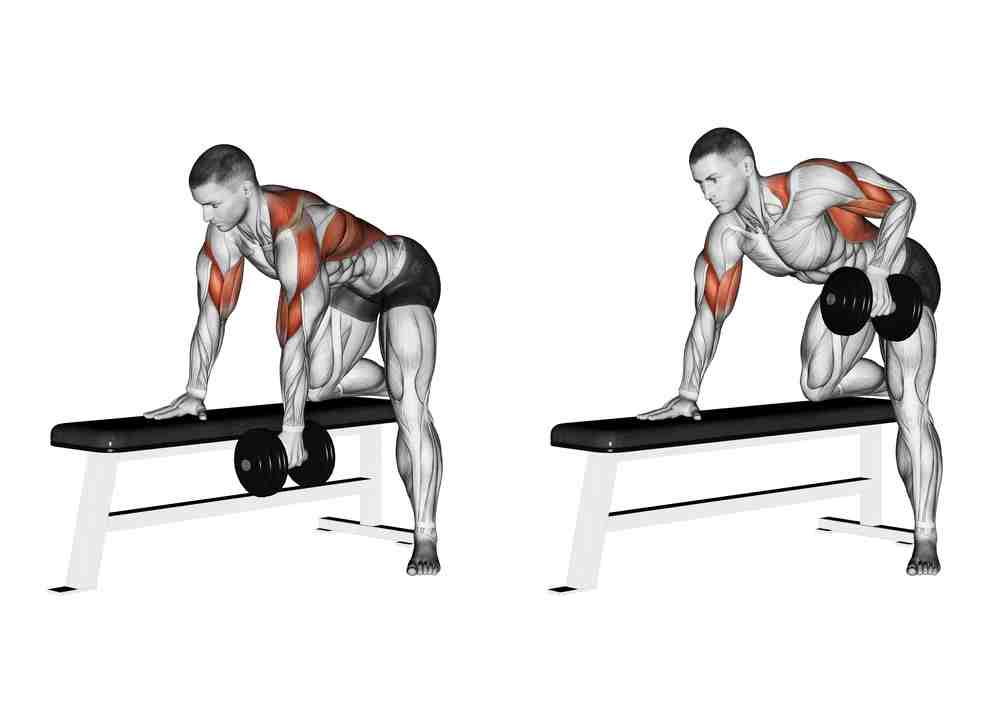
- Process: Bend at the hips, keep your back straight, hold dumbbells, and pull them towards your hips while squeezing your shoulder blades.
- Target Muscles: Latissimus dorsi (lats), rhomboids, biceps, and lower trapezius.
- Tips: Maintain a neutral spine, engage your core, and use controlled movements to avoid straining your lower back.
2. Incline Dumbbell Row
A variation of the bent-over row performed on an incline bench, focusing on the upper back muscles.

- Process: Lie face-down on an inclined bench, hold dumbbells, and row them towards your hips, squeezing your shoulder blades.
- Target Muscles: Upper back muscles (rhomboids and trapezius), rear deltoids, and biceps.
- Tips: Adjust the bench to a comfortable angle, and use a weight that allows you to maintain proper form throughout the exercise.
3. One-Arm Dumbbell Row
A unilateral exercise that isolates each side of the back for balanced development.
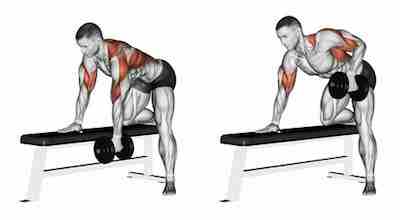
- Process: Place one knee and hand on a bench, hold a dumbbell in the opposite hand, and row it towards your hip while keeping your back straight.
- Target Muscles: Latissimus dorsi (lats), rhomboids, biceps, and lower trapezius.
- Tips: Keep your core engaged for stability, and avoid using momentum by performing the movement in a controlled manner.
4. Renegade Row
A challenging exercise that combines a rowing motion with a plank, engaging multiple muscle groups.
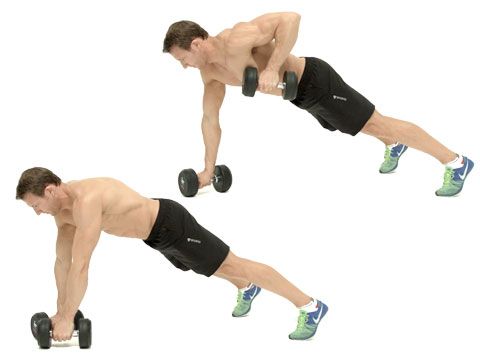
- Process: Start in a high plank position, hold dumbbells in both hands, row one dumbbell towards your hip while balancing on the other arm.
- Target Muscles: Back (lats and rhomboids), biceps, core, and shoulder stabilizers.
- Tips: Maintain a strong plank position, avoid rotating your hips, and start with lighter weights until you’re comfortable with the movement.
5. Dumbbell Pullover
An exercise that targets the muscles of the upper body, particularly the back and chest.
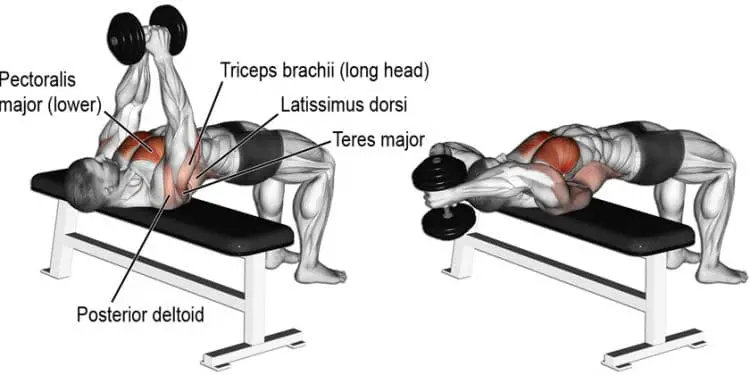
- Process: Lie on a bench, hold a dumbbell with both hands above your chest, and lower the dumbbell backward in an arc while keeping your elbows slightly bent.
- Target Muscles: Latissimus dorsi, pectoralis major (chest), triceps, and serratus anterior.
- Tips: Focus on the stretch in your lats as you lower the dumbbell, and avoid overextending your shoulders or letting your lower back arch excessively.
Incorporating these exercises into your back and bicep workout routine can provide a well-rounded approach to strengthening and sculpting your upper body.
Bicep Exercises with Dumbbells
When it comes to sculpting strong and defined arms, bicep exercises with dumbbells are a go-to choice for many fitness enthusiasts. Dumbbells provide a versatile and effective way to target the biceps, helping you achieve those sought-after “guns” you’ve been aiming for. Here we’ll explore some key bicep exercises using dumbbells that you can easily incorporate into your workout routine.
1. Dumbbell Curls
Dumbbell curls are a classic bicep exercise involving alternating arm curls with a dumbbell in each hand.
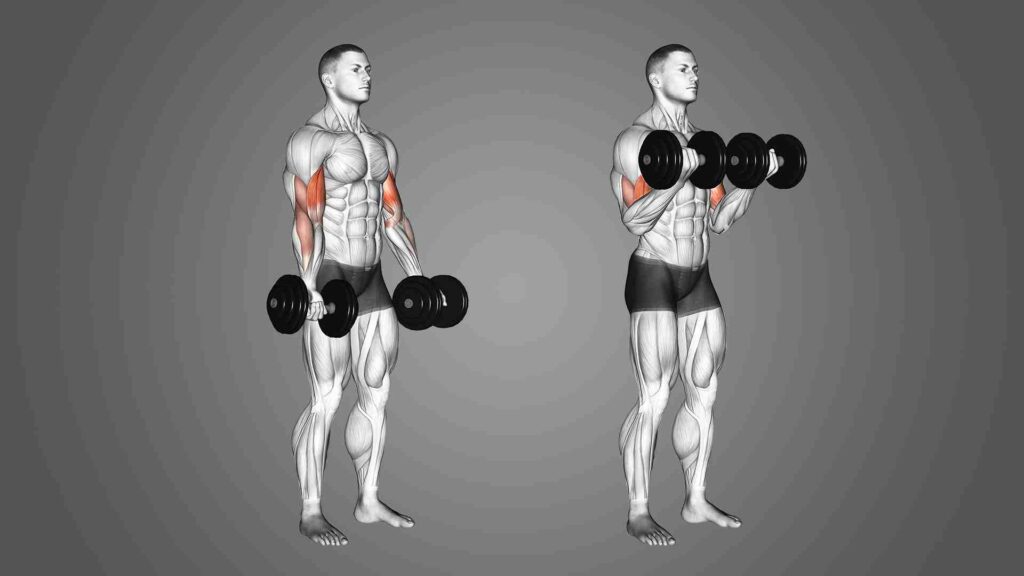
- Process: Stand with a dumbbell in each hand, palms facing forward. Curl one arm while keeping the elbow stationary, then lower and repeat with the other arm.
- Target Muscles: Primarily targets the biceps brachii, helping to build size and strength in the front of the upper arm.
- Tips: Maintain a stable torso, avoid swinging, and use controlled movements for maximum effectiveness.
2. Hammer Curls
Hammer curls provide variation by working both the biceps and brachialis muscles with a neutral grip.
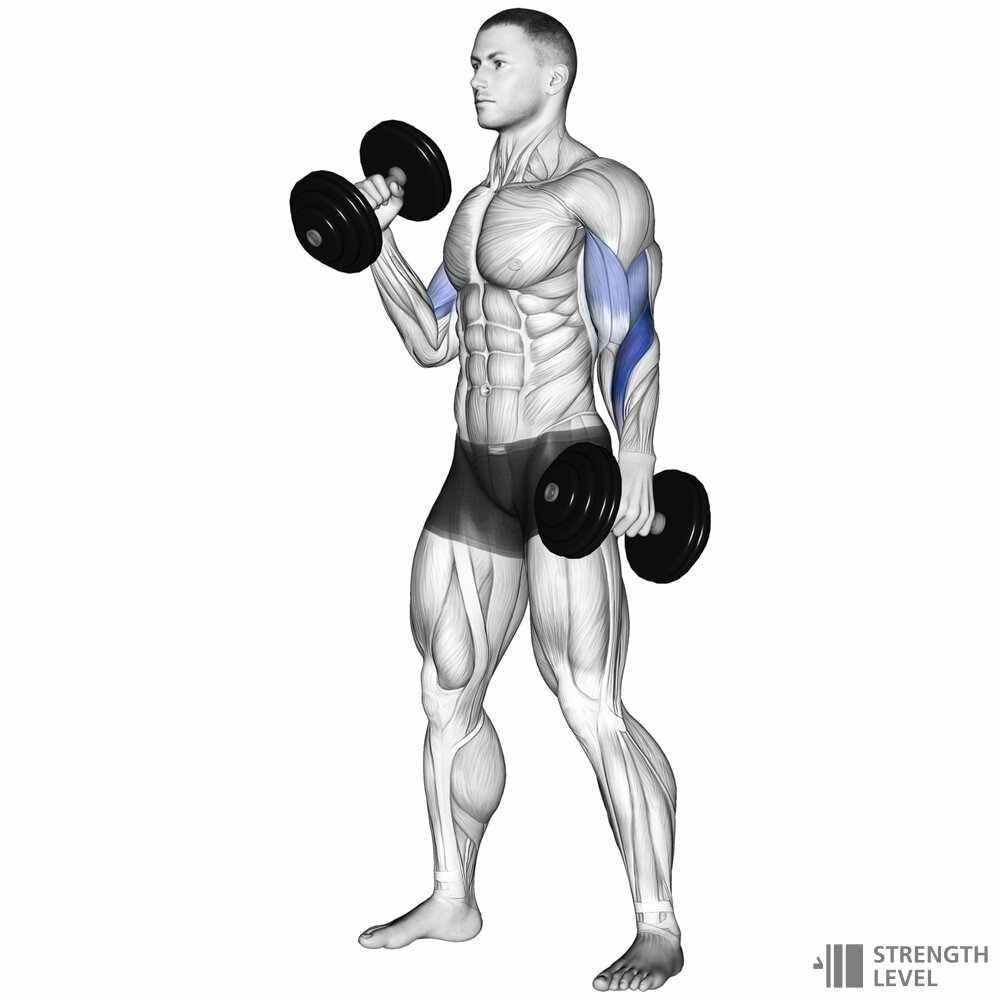
- Process: Hold a dumbbell in each hand with palms facing your body. Alternately curl the weights while keeping the palms facing in.
- Target Muscles: Focuses on the brachialis muscle as well as the biceps, contributing to overall arm thickness.
- Tips: Keep the upper arms stationary, engage the core, and avoid excessive wrist movement.
3. Incline Dumbbell Curls
Incline dumbbell curls are performed on an inclined bench to target the biceps’ long head effectively.

- Process: Lie on an inclined bench, let the arms hang with dumbbells, and curl while maintaining the incline.
- Target Muscles: Emphasizes the biceps’ long head for a well-rounded arm appearance.
- Tips: Use a controlled tempo, maintain the incline angle, and focus on the stretch and contraction of the biceps.
4. Concentration Curls
Concentration curls isolate the biceps by eliminating any momentum or assistance from other muscles.
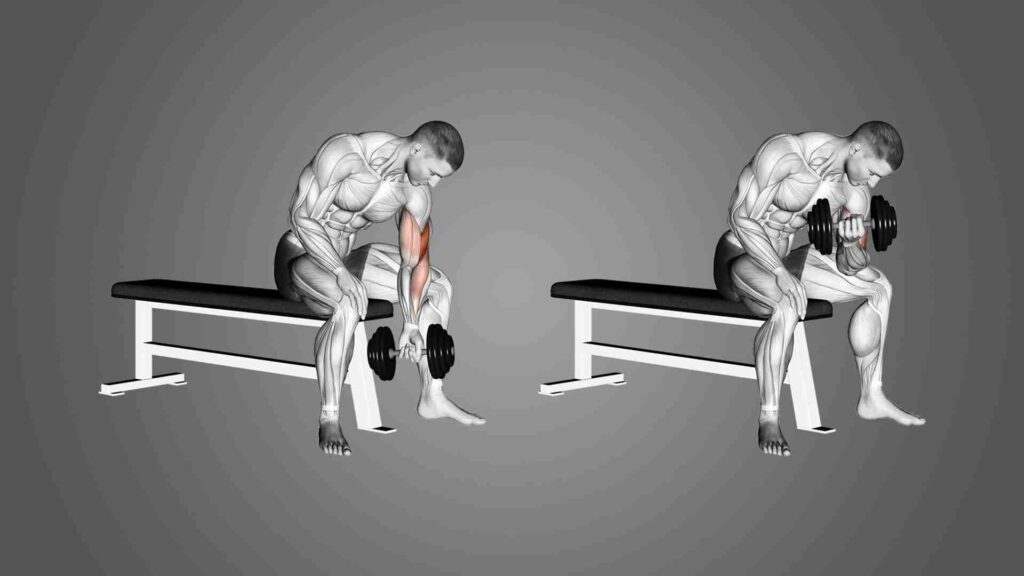
- Process: Sit on a bench, elbow resting on the inner thigh, and curl the dumbbell while focusing on the squeeze at the top.
- Target Muscles: Isolates the biceps brachii, aiding in peak contraction and muscle definition.
- Tips: Keep the upper arm stationary, control the movement, and use a full range of motion.
5. Preacher Curls
Preacher curls are performed on a preacher bench, isolating the biceps by minimizing shoulder involvement.
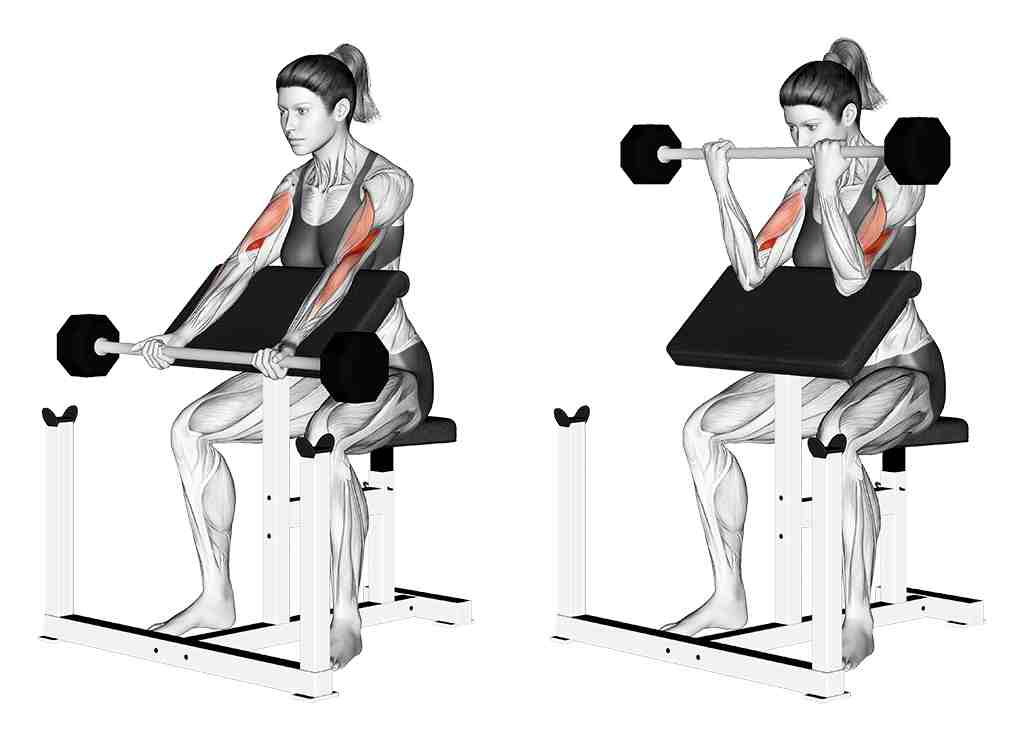
- Process: Sit at the preacher bench, arms resting on the pad, and curl the dumbbells using a controlled motion.
- Target Muscles: Isolates the biceps brachii and helps in achieving a pronounced peak.
- Tips: Maintain proper form, avoid using excessive weight, and focus on the contraction at the top of the curl.
Incorporating these diverse dumbbell curl variations into your workout routine will lead to comprehensive bicep development, enhance arm strength, and contribute to an aesthetically pleasing upper body physique.
Integrated Back and Bicep Workout Routine
Here is an integrated back and biceps workout routine that you can follow:
Warm-up
- 5 minutes of light cardio, such as jogging or jumping jacks.
- 10-15 reps of each of the following exercises:
- Banded shoulder rotations
- Banded chest flyes
- Banded bicep curls
Back workout
- Barbell rows: 3 sets of 8-12 reps
- Pull-ups: 3 sets to failure
- Seated cable rows: 3 sets of 10-15 reps
- Lat pulldowns: 3 sets of 12-15 reps
- Face pulls: 3 sets of 15-20 reps
Biceps workout
- Barbell curls: 3 sets of 8-12 reps
- Hammer curls: 3 sets of 10-15 reps
- Preacher curls: 3 sets of 12-15 reps
- Zottman curls: 3 sets of 15-20 reps
Cool-down
- 5 minutes of light cardio.
- Stretching for all major muscle groups.
You can adjust the number of sets and reps depending on your fitness level. If you are a beginner, start with 3 sets of 8-12 reps for each exercise. As you get stronger, you can increase the number of sets and reps.
SHOP FOR THE BEST QUALITY PROTEIN POWDER ON AMAZON
It is also important to focus on proper form when doing these exercises. This will help to prevent injuries and ensure that you are getting the most out of your workout.
Nutrition Tips for Muscle Recovery and Growth
Here are some nutrition tips for muscle recovery and growth, along with pre and post-workout nutrition strategies:
- Eat enough protein. Protein is essential for muscle repair and growth. Aim to consume 1.2-1.7 grams of protein per kilogram of body weight each day. Good sources of protein include lean meat, fish, poultry, eggs, dairy products, beans, and lentils.
- Eat complex carbohydrates. Complex carbohydrates provide your body with energy, which is important for muscle recovery. Good sources of complex carbohydrates include whole grains, fruits, and vegetables.
- Drink plenty of fluids. Staying hydrated is important for overall health and well-being, and it is especially important for muscle recovery. Aim to drink 8-10 glasses of water each day.
- Eat fruits and vegetables. Fruits and vegetables are packed with vitamins, minerals, and antioxidants that are essential for overall health and well-being. They are also a good source of fiber, which can help you feel full and satisfied after eating.
- Consider taking a post-workout protein shake. A post-workout protein shake can help your body repair and rebuild muscle tissue. Look for a shake that contains 20-30 grams of protein and is low in sugar.
Pre-workout nutrition:
- Eat a light meal or snack 30-60 minutes before your workout. This will give your body the energy it needs to perform at its best.
- Choose foods that are high in complex carbohydrates and protein, such as a piece of whole-wheat toast with peanut butter or an apple with a hard-boiled egg.
- Avoid sugary foods and drinks, as these can cause a rapid spike in blood sugar followed by a crash.
Post-workout nutrition:
- Eat or drink a source of protein within 30 minutes of finishing your workout. This will help your body start the muscle repair process.
- Good choices include a protein shake, Greek yogurt, or a hard-boiled egg.
- You can also eat a small meal or snack that contains complex carbohydrates and protein.
- Avoid sugary foods and drinks, as these can interfere with muscle recovery.
Here are some additional tips for maximizing muscle recovery and growth:
- Get enough sleep. Sleep is essential for muscle repair and growth. Aim for 7-8 hours of sleep each night.
- Manage stress. Stress can interfere with muscle recovery. Find healthy ways to manage stress, such as exercise, yoga, or meditation.
- Stay hydrated. Staying hydrated is important for overall health and well-being, and it is especially important for muscle recovery. Aim to drink 8-10 glasses of water each day.
- Listen to your body. Don’t overdo it at the gym. If you’re feeling pain, take a break.
Effective Exercises for Winging of Scapula
By following these nutrition tips, you can help your body recover from your workouts and build stronger, more muscular muscles.
Common Mistakes to Avoid
Here are some common mistakes to avoid during your back and bicep workout with dumbbells:
1. Using Momentum: Swinging the dumbbells or using momentum to lift the weights takes the focus off the targeted muscles and increases the risk of injury. Ensure controlled and deliberate movements.
2. Neglecting Proper Form: Poor form can lead to ineffective workouts and potential injuries. Maintain a neutral spine, engage your core, and follow the correct range of motion for each exercise.
3. Lifting Excessively Heavy Weights: Selecting weights that are too heavy can compromise your form and increase the risk of strains. Choose weights that challenge you while allowing you to perform exercises with proper technique.
4. Rushing Through Repetitions: Performing exercises too quickly reduces the time your muscles spend under tension. Aim for controlled, steady repetitions to maximize muscle engagement and growth.
5. Neglecting Warm-up and Cool-down: Skipping warm-up exercises and post-workout stretching can lead to muscle stiffness and potential injuries. Always include a proper warm-up and cool-down routine.
6. Overtraining: Giving your muscles sufficient time to recover is essential for growth. Avoid working the same muscle groups on consecutive days to prevent overtraining and promote recovery.
7. Ignoring Breathing Technique: Proper breathing helps stabilize your body and provides oxygen to your muscles. Breathe out during the exertion phase and inhale during the relaxation phase of an exercise.
8. Focusing Exclusively on Weight: While weight progression is important, focusing solely on lifting heavier weights can lead to imbalances. Incorporate variety and focus on muscle engagement.
SHOP FOR THE FITNESS TRACKER ON AMAZON
By avoiding these common mistakes, you’ll ensure a safer, more effective, and rewarding back and bicep workout with dumbbells.
FAQs
Q 1. Can I do this workout at home?
Ans. Absolutely! This workout is designed to be done at home with a pair of dumbbells. You won’t need any complicated equipment or machines.
Q 2. How frequently should I perform this routine?
Ans. For optimal results, aim to perform this workout routine 2 to 3 times per week. Make sure to allow a day of rest between sessions to let your muscles recover.
Q 3. Are there alternatives if I can’t do a certain exercise due to injury?
Ans. If you’re dealing with an injury, it’s important to consult a healthcare professional before attempting any exercises. Depending on your injury, they can provide you with alternative exercises or modifications that won’t aggravate your condition.
Q 4. How long before I start seeing results?
Ans. Results can vary from person to person, but with consistent effort and a balanced diet, you can start noticing improvements in strength and muscle definition within 4 to 6 weeks. Patience is key; remember that long-lasting results take time.
Q 5. Can women benefit from this workout too?
Ans. Absolutely! This workout routine is not gender-specific and can benefit anyone looking to build strength in their upper body. Women can achieve toned and strong back and bicep muscles by following this routine consistently.
Q 6. Can I use water bottles if I don’t have dumbbells?
Ans. While water bottles can work in a pinch, it’s recommended to invest in a pair of actual dumbbells. They offer better grip and weight distribution, which will contribute to a safer and more effective workout.
Q 7. How often should I train my biceps?
Ans. Biceps are small muscles that recover relatively quickly. You can train your biceps 2-3 times a week, but avoid consecutive days to allow for proper recovery.
Conclusion
Achieving a strong and balanced upper body doesn’t require an elaborate gym setup. With the right techniques and dedication, a back and bicep workout using dumbbells can yield remarkable results.
Remember, consistency and proper form are key. Incorporate this workout routine into your fitness journey and witness the transformation of your back and bicep muscles, leading you towards a healthier and more powerful you.

Good day, and welcome to Fitthour. My name is Shubham Vijay, and I am a certified personal trainer and nutrition coach with 6 years of experience in the fitness industry. At Fitthour, we specialize in types of training, such as strength training, cardio, or HIIT, and our mission is to help clients achieve their fitness goals and improve their overall health.

